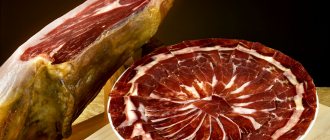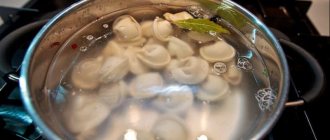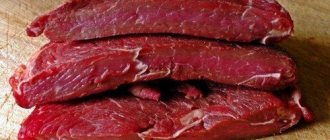Products can be stored longer, maintaining all their properties and features, if you use special modern techniques. Nowadays there is a demand for storing meat in vacuum packaging. This is a proven method thanks to which raw meat and meat products stay fresh on average three times longer.
Many people prefer to buy vacuum bags for meat to ensure maximum shelf life of the product. In specialized companies, such materials are sold in assortment, and due to the reliability of storage methods, they are always in high demand.
Now we will try to consider the key features of this method.
Classification of heat treatment of meat
Each type of heat treatment of meat has its own characteristics.
For example, it is considered paired within one and a half hours after the slaughter of the animal. It has a natural temperature and cools down over time. Due to the fact that the muscles are still very tense, it is quite rigid. In order for them to relax and the meat to acquire the necessary softness, you should wait several days. Chilled is the one that, after cutting the carcass, is put into the refrigerator and cools down there. The top is covered with a natural crust. The temperature of chilled meat does not exceed +4 degrees.
Frozen meat is different in that only the outer part is frozen; the inside remains unfrozen.
And in order for the meat to be stored longer and not spoil, withstanding long transportation, deep freezing is used.
Cooking meat and poultry at low temperatures on the stove
For simmering on the stove, you can use the toughest and densest pieces of meat, that is, the working muscles of the animal. The best cuts of beef to simmer on the stove are: front and back shanks, brisket ribs, and outer rear cuts. Pork: knuckle, ham, legs, boneless brisket. Chicken: breast, thighs, whole bird, cut into portions. In order for the toughest pieces to soften and the collagen to turn into gelatin, long-term temperature maintenance
60-80 °C. How to achieve temperature accuracy? The easiest way is in a slow cooker (1) - this is described in detail in the chapter “How to cook sous vide meat without a sous vide machine.” The second simple option is on an induction hob (2): with the minimum thermostat settings, exactly this temperature is achieved, although it is better to check with a thermometer. And finally, on other stoves (conventional electric, glass-ceramic or gas). Here you need a thermometer (3), which you will have to dip into the sauce from time to time to see if the temperature has risen too high. To reduce the heating level, use a divider (4) for a gas stove. And on an electric burner you can put a ring (5) folded from tightly twisted foil - and place the dishes with meat on it. The simmering vessel itself must be spacious enough and have a thick bottom (made of several layers of metal, double or triple) and preferably thick walls. This can be stainless steel (6) or coated cast iron (7). Cast iron (duckling and goose pans) is an ideal cookware for simmering both on the stove and in the oven: it distributes heat as evenly as possible. If you don’t have the opportunity to wait for hours for your dish to be prepared, you can always replace this labor-intensive process with tender and soft ready-stewed meat from Miratorg - it simmered in natural marinades and sauces directly in the package at 95 ° C for more than two hours.
Processing and slicing
Most often, meat and poultry for simmering on the stove are cut into portions or very small pieces. You can simmer the whole thing, but the product must be completely covered with liquid (1) or the pan must have a lid that fits without gaps - so that the resulting steam remains inside and does not allow the protruding piece of meat to become dry. Otherwise, the processing of meat for simmering is the same as for baking (2). If there is a layer of fat on the meat, when simmering, place the piece with the fat side up so that it gradually melts and enriches the meat with its taste (3). The processed meat can be immediately fried until golden brown and then immersed in liquid, or vice versa - simmer first and fry, removing the sauce when it is completely cooked. Both options have a right to exist, but the taste is different - try it and decide which one you like. Sauces for simmering
In order for the meat to be better saturated with flavors during simmering, ingredients with the appropriate qualities must be added to the cooking liquid. The most versatile base for sauce is broth. Moreover, it is not necessary to use chicken for chicken, and beef for meat. Using a “different” broth enriches the taste of stewed meat. Instead of salt, you can add salt to the broth, but its substitutes - soy or Asian fish sauce. An excellent element of simmering sauce is chopped tomatoes, fresh or canned in their own juice. You can also use ready-made tomato sauce with a minimal addition of vinegar or a small amount of tomato paste. In the same small quantities you can add dry wine, lemon juice or other sour fruits. Unlike frying over high heat, you can use unrefined oils when simmering. Since the temperature in the pan is low, you can choose any oil you like - even sunflower or sesame, which burn over medium heat. Olive, mustard, nut and flaxseed oils are also suitable. Fresh herbs can be added either halfway through cooking or at the very end, while dried herbs can be added only at the beginning. Spices for long-term simmering are more suitable whole, unground: coriander, cinnamon, cumin, star anise, barberry, peppercorns, cardamom, mustard seeds... Spices can be placed in a fabric bag so that later you do not need to strain the sauce. It is better not to keep the bay leaf in the sauce for longer than 15 minutes - it begins to smell unpleasant and taste bitter. Try not to combine rosemary with bay leaf and/or juniper - you will not feel the taste of meat behind them. If the vegetables in the sauce are boiled, beat the sauce with a blender - this will make the dish look much more attractive
Benefits of chilled meat
Chilled beef, pork or chicken is always ready for immediate cooking. Frozen meat must first thaw, which takes a lot of time. At the same time, using a microwave significantly speeds up the process, but it is not always possible to achieve a good result. In some cases, especially when the piece is thick enough, it happens that the meat is still frozen inside, but is already fried on top. Therefore, if you plan to prepare a delicious dish, you need to take the product out of the freezer in advance.
Another advantage of chilled meat compared to frozen meat is that it retains all the beneficial substances. It is also considered the most delicious.
Storing meat in vacuum packaging
To keep meat chilled for a long time, they came up with vacuum packaging that is filled with a special gas that replaces oxygen. This allows you to stop all bacterial growth processes that lead to product spoilage.
Storing chilled meat in vacuum packaging while maintaining all its properties can last up to 10 weeks. It is unlikely that it is important for an ordinary consumer that a piece of beef be stored in his refrigerator for three to four months.
Long-term storage of unfrozen meat is necessary for sellers. This is due to better demand and higher prices. Since a buyer who comes into a store after work has a greater desire to purchase meat that can be immediately put in a frying pan, rather than frozen.
In order for the shelf life of chilled meat to be so long, it is necessary to monitor the temperature in the refrigerator compartment. It must be constant and at a certain level. Otherwise, the period will be greatly reduced. With this method of preservation, the color of the meat and its smell may change. By the way, blue color is not an indicator of a spoiled product; this color is quite natural for storage in a vacuum. After opening the package, the color should return to its natural state and the smell should disappear.
General information
To vacuum food at home, you can use a vacuum container or a special device - a household vacuum sealer. What are the advantages of vacuum food storage?
The main ones include:
- Keeping food fresh for a long time, in some cases, even without storing it in the refrigerator;
- Isolation from foreign odors present in storage areas;
- Preservation of beneficial properties;
- Save space in the refrigerator and freezer.
In addition to the obvious advantages, this process allows you to significantly save money. Since it is possible to preserve vegetables and fruits purchased in the summer in this way and use them in food during the cold season, their price in stores and markets is much higher.
Storage rules
To prevent meat from losing freshness and quality in the freezer, make sure it is properly cut and prepared.
Before you put your piece in the freezer, prepare it. Determine in advance what you will cook from the carcass and divide it into appropriate portions. This will allow you not to defrost the entire piece if only part of it is required for the dish, since repeated freezing will lead to a loss of product quality.
Do not wash meat under any circumstances. This leads to loss of quality and faster spoilage, since the liquid penetrates the fibers and expands when frozen, which leads to a breakdown in the structure of the fillet. If you want the product to last a long time, grease each piece with sunflower oil.
Do not keep meat in the chamber without packaging, otherwise the fibers will darken and lose some of their beneficial properties. It's best to wrap each piece in cling film or a plastic freezer bag. Place different varieties only in different bags. Try to ensure that the packaging does not come into contact with other products in the chamber, since their bacteria can penetrate into the meat even through polyethylene.
For convenience, label each package indicating the date of freezing and the type of product.
https://www.youtube.com/watch{q}v=Yoi_a9X-omQ
We suggest you familiarize yourself with: Time-based or salary wage system
Most freezers are equipped with a temperature controller. Here you can set the temperature from 0 to -24 degrees. The temperature at which the meat will lie without losing quality depends on the shelf life. For example:
- in a chamber with a temperature of 0 to -6 degrees, the meat will lie for 2–3 days; if it is not a fillet, but a piece on the bone, the period will be reduced to 24–48 hours;
- at temperatures from -6 to -12 degrees, fillets, whole carcass or portioned pieces will maintain quality for 4 months;
- the product will not lose taste and quality for six months if it is kept in the freezer at a temperature of -18 degrees;
- at temperatures from -18 to -24 degrees, a fillet or piece on the bone will last for at least 18 months, but its structure may change during long-term storage.
Of course, meat cannot sit in the freezer for too long. Over time, its mass decreases, and the fibers lose useful molecular compounds. The fact is that freezing does not stop the development of biochemical reactions, but only slows them down. In addition, structural changes in some protein enzymes do not slow down even at very low temperatures, and lipid compounds change composition over a long time.
Consumer attitudes towards different packaging options
The requirements of consumers and retail chains for the quality of meat products are rapidly increasing. The main attention is focused on reasonable cost, quality and ease of consumption. The listed factors contribute to the active introduction of new methods of meat packaging in retail chains. However, researchers have found that quality assessment and attitude towards products in a modified environment have a contradictory effect. When purchasing, consumers focus on the benefits of products for their own health. People also evaluate the visual characteristics of meat. Appearance, color, juiciness, smell and taste also affect consumer qualities.
When conducting research, many experts preferred meat that was kept in an atmosphere with a total oxygen content of less than 50 or 80%. Although the product may have tasted slightly rancid, this taste preference may have been due to customers' taste buds adapting to oxidized fats. It was later discovered that color had no effect on the enjoyment of eating meat. However, many consumers pay attention specifically to color, thinking that it is an indicator of freshness and positive taste. Buyers rank individual meat properties in order of importance. Approximately 50% of people believe that tenderness is the most important parameter. At the same time, 38% pay attention to taste properties and 11% of consumers focus on juiciness.
conveyor packaging
In the modern world, people are also demanding environmentally friendly and safe packaging. Accordingly, manufacturers are actively developing new packaging options. Recent advances include packaging made from biodegradable polymers. Manufacturers are also studying various food gases and their effect on the properties of products.
Freezing chilled meat
If there is a need to freeze chilled meat, then you should follow some rules:
- if the piece is large, you need to divide it into several small ones;
- it must not be washed;
- All air should be removed from the bag in which the piece of meat is placed;
- It is desirable that the freezing process be as shock as possible, so the temperature in the freezer should be set to the very minimum;
- since meat cannot be stored forever even in the freezer, you need to put notes in the bags with the freezing date, which will help you keep track of the expiration date;
- After the piece is completely frozen, it should be dipped in a pan of cool water and put back in the freezer. The top of the package will be covered with a crust of ice and the frozen, chilled meat will retain a sufficient amount of water.
Ways to increase shelf life
In terms of time, meat is stored longest in the freezer at a temperature of minus 18 degrees or lower. The shelf life of a meat product directly depends on the type of product and what cutting option was used. It can be a separate piece, a whole carcass, minced meat.
Large pieces of beef, lamb, and pork can last from 4 months to 1 year. The less time the product is in ice, the more it retains its qualities. Small pieces, goulash, cannot be stored in the freezer for more than 4 months. Poultry pieces no more than 8 months old.
Whole bird
The carcass of the poultry product can be stored throughout the year. The shelf life depends on the conditions in which the bird is stored and what type it is. The optimal storage period at temperatures from -12° to -15° for geese and ducks is a week. Chickens, turkeys and guinea fowl - 10 days. At a temperature of -25° for 14 months.
Poultry meat cut into pieces can be stored for up to 8 months.
Cooked meat
Boiled meat with broth can be stored for 48 hours, without broth for 24 hours. It can be kept frozen for no more than 2 weeks; after defrosting, the boiled product must be immediately stewed or boiled again.
When fried, the meat is wrapped in foil and stored in the refrigerator for no more than 72 hours, at a temperature of 2° - 4°. It is advisable to fry it again later.
Minced meat and offal
Since minced meat and offal can quickly spoil, it is not recommended to keep them in the refrigerator for more than 8 hours. After this time, you need to place these products in the freezer, wrapping them in foil or a plastic bag. The shelf life is 2 months.
Meat, like meat products, can be frozen by various methods: in air, salt solutions, boiling refrigerants, or in direct contact with metal plates of freezing units.
The most common method of freezing meat in air comes in the form of two methods:
- Single-phase, in which fresh meat is immediately frozen.
- Two-phase, when fresh meat is first cooled to a temperature of approximately 4°C, and then frozen at -8°C and below.
The most commonly used in industry is a two-phase method for freezing cattle, pork or lamb meat. Based on the freezing speed, they are divided into:
- Slow freezing, carried out at a temperature of -18°C...-23°C, air movement at a speed of 0.1m/s - 0.2m/s and humidity of about 90%-95%. This freezing lasts about 35-40 hours.
- Intensive, carried out at a temperature of -23°С...-30°С, air speed 0.5 m/s - 0.8 m/s and humidity 90%-95% for 28 hours.
- Fast, at which the air temperature is -30°C...-35°C, the air flow speed is from 1 to 4 m/s. Freezing meat using this method lasts about 18 hours.
Go to Dismissal as a person who has not completed the probationary period on sick leave
Freezing of meat in production is carried out in a suspended state on overhead tracks, while the most voluminous parts (thighs) are placed on top, where air flow is maximum. The distance between carcasses, half-carcasses and quarters should be within 3 - 5 cm.
Contact freezing, which is performed when interacting with a surface at low temperatures, allows you to reduce the freezing time of meat by 1.5 - 2 times. With this method, meat blocks are placed between frozen metal plates located in special freezing equipment.
How to properly bake meat and poultry in the oven at low temperatures
To get great results when preparing different dishes, you need to understand very well what exactly you are doing. General rule: the more “working” the cut was (the neck bends, the legs move, etc.), the more time it will take to cook it. The best cuts of beef to simmer in the oven are: boneless brisket, sirloin, inside back, eye muscle. Pork: shoulder, ham, brisket. Chicken: the whole bird, legs, wings.
Need to remember:
The larger the piece, the better it is suitable for baking in the oven using the “dry” method. The larger it is, the lower the temperature should be and the longer the time. The more fat there is in a piece, the better it is to bake it “dry” - the fat will gradually melt and make the meat juicy. The less fat, the more often the piece needs to be greased with sauce during baking.
Temperature
At what internal temperature is meat considered cooked and safe? chicken - 73 °C pork - 62 °C beef - 52-60 °C
We have experimentally established that long-term baking of pieces of meat works best at 120-130 °C. For fattier pieces - at 140 °C. This way the meat is cooked for 2 to 6 hours, depending on the size and quality. The temperature can be reduced to 60-70 °C, but the time increases to 10-12 hours. High temperature - 180-240 °C - is needed for a short time to get an appetizing crust on the meat. Processing and slicing
Before baking large pieces of meat do not need to remove any fat or film from the surface. You can even leave the skin. All of them will serve to protect meat juices and aromas from evaporation - this is a natural meat “packaging”. When baked for a long time, they will have time to soften enough, and the pork skin, fried under the grill at the last stage of cooking until crunchy, becomes a real delicacy. If you want to stuff meat, make cuts only at the top, but almost throughout the entire depth (1). If you need to cut the meat into smaller pieces for baking, follow the natural “cutting” - the meat has tendons and films running along the fibers. If you separate the meat into them, the pieces will not fall apart further, and this “coating” can also be left as protection (2). If you want to get beautiful portioned pieces, then, of course, the meat will need to be cut across the grain. The thickness of the pieces is at least 2 cm so that the meat does not become dry (3). There is no point in cutting meat finely for long-term baking.
Spices and marinades
There is also a general principle here: the fattier the meat, the more aromatic spices it requires.
This is, first of all, coriander, star anise, allspice, paprika, nutmeg, cardamom. To make this meat better absorbed by our body, you can add fennel seeds. Spicy vegetables and herbs won’t hurt either: garlic, ginger, thyme, rosemary, oregano. However, they are also perfect for lean meat along with more delicate spices: black and pink pepper, cumin, sumac, turmeric. Fatty meats love dry marinades, where spices and chopped herbs are mixed and rubbed into the surface of the meat from all sides. Lean meat is best marinated in different types of unrefined oil: olive, peanut, sesame, walnut oil, adding soy sauce or salt. Adding onions to the marinade gives the finished meat an onion flavor, like in classic Soviet shish kebab - not everyone likes it. But if you like it, then chopped onions with salt and pepper are a self-sufficient option; you don’t need to add anything else to it. And after the meat is marinated, the onions can be fried and served along with the meat. You need to remember:
The larger the piece of meat and the fattier it is, the longer it is marinated - from 2 to 24 hours. Marination with the “acid” component should be quick: 30 minutes. — 1 hour If you don’t have much time for marinating, cover the container with the meat in the marinade with film and leave at room temperature for 2 hours - that’s enough. Store the fermented milk marinade in the refrigerator from the very beginning; you can keep meat in it for quite a long time - up to a day. Marinades containing acid (vinegar, wine, lemon juice, tomato paste) are quite aggressive, quickly softening - and subsequently destroying - the top layer of meat without reaching the core. Do not add acid for softness - good meat does not require it, add only a little for taste and aroma. Other types of marinades—yogurt or kefir, teriyaki or oyster sauce—work best for poultry and fatty cuts of pork. You can add an “Asian set” to them: ginger, garlic, chili, curry powder or paste, cilantro and green onions.
Is chilled meat always better than frozen?
Meat is an excellent place for pathogenic bacteria to live. Therefore, its storage at above-zero temperatures is possible for a short time. Vacuum packaging, which preserves chilled meat, whose shelf life is significantly increased due to the inhibition of bacterial growth, requires that the ideal storage temperature be slightly below zero. But since no one knows what kind of product is on the store counter, how long and under what conditions it was stored, there is a risk of purchasing an already spoiled product.
Meat can be frozen in different ways, which gives completely different results. In domestic conditions, when meat goes into the freezer, it freezes gradually. At this time, quite large particles of ice form inside, which destroy its fibers. That is why, when defrosted, the product loses its attractiveness and looks more friable. And due to excessive loss of moisture, it becomes tough and tasteless.
On an industrial scale, a different technology is used. Meat is frozen at extremely low temperatures and with strong air circulation. Such shock freezing leads to the formation of small water crystals that do not have a destructive effect on the structure of the meat. Therefore, when thawed and cooked, this product will taste almost the same as chilled meat.
A frozen product is easier to transport and store without worrying about its safety.
The downside of packing meat in a gas environment with a high oxygen content
It is a known fact that oxygen in large quantities promotes the oxidation of fat in the structure of meat. Accordingly, the product gets a rancid taste, which repels buyers. The problem is the excessive formation of cholesterol oxidation products, which negatively affects the health of consumers. Through laboratory studies, it was found that with an oxygen content of 70%, the composition of cholesterol oxides increases to 86.4%. Oxygen also promotes the activation of protein oxidation. This effect leads to a decrease in meat tenderness and loss of juice.
That is why it is extremely important to correctly select the gas composition of packaging mixtures, since the main task is to select favorable and safe conditions for storing fresh meat. The development of special packaging is aimed at increasing the convenience, quality and speed of product sales. In this case, all environmental aspects, requirements for protection against counterfeiting and weight reduction are taken into account.
Specialists in food mixtures https://idealgaz.ru/foodmix/ will be happy to advise you on all your questions and help with the selection of mixtures of the correct concentration to preserve the presentation and taste of the products.
How long can cooked meat be stored in the freezer?
Shelf life depends not only on environmental conditions, but also on the type of meat.
Chicken carcasses will last in the freezer without loss of quality for 9 to 12 months. If the chicken is divided into parts, the shelf life is reduced to 8-9 months.
As with any other variety, keep the chicken in a separate, tightly sealed plastic bag.
The shelf life is also affected by the form in which you purchased the product. If you purchased fresh chicken, it will actually last about a year in the freezer.
Be careful with frozen carcasses. The fact is that the packaging may contain information about the date of packaging and freezing, which does not correspond to the time of death or cutting of the chicken.
You cannot be sure that the stated period is correct. If you bought a frozen product, protect yourself and reduce the storage time in the freezer to six months.
Statistics and fundamentals
Recently, the proportion of fresh meat that is packaged in a protective environment has increased from 32 to 43%. The remainder is packaged in other ways or frozen. Packaging meat in a gas environment involves excluding air (and its constituent oxygen) from the packaging and replacing them with special gas mixtures, for example, carbon dioxide and nitrogen. The use of CO2 is due to its bacteriostatic effect. In this case, the minimum permissible concentration of carbon dioxide must be at least 20%, in which case the effect of suppressing bacteria can be guaranteed. Typically, the modified environment consists of 60-80% O2 and 20-40% CO2. In this case, oxygen can be used in higher concentrations to obtain the desired red color of fresh meat.
In practice, maintaining hygiene during meat processing and subsequent packaging in a modified gas atmosphere allows a shelf life of 7-9 days at a temperature of 7 °C. In this case, a nitrogen content of up to 10% is allowed to normalize the pressure inside the package. It should be noted that nitrogen is the main protective gas, which is absolutely neutral to products and has no taste or smell. Manufacturers often consider edible gas mixtures as a direct alternative to vacuum packaging.
The key to overall success is following the recommended sequence of meat preparation and packaging. After all, packaging is necessary not only to convey important information about the product (its color and freshness), but also must be extremely simple and easy to use. At the same time, the base of the packaging container must be made of safe and durable materials that can minimize the risk of damage or depressurization during transportation. The use of high-quality packaging helps prevent the risk of steam and moisture forming on the surface of the product. As a rule, fresh meat is placed in PP or PET trays, and a dense film of polyethylene, polypropylene or polyvinyl chloride is used as an insulating material. However, combined films have the best performance. Manufacturers often use multilayer films based on ethylene copolymers or PVDC. In practice, this type of packaging is considered more expensive.
How to choose chilled meat
In order not to be mistaken with the quality of meat, you need to carefully consider its choice. Firstly, color is important. If the beef is too light, then this is a reason to be wary, as this is an indicator of the animal being too young. Such people are not allowed to be slaughtered without compelling reasons. Meat that is too dark, with a gray tint, indicates that it is not fresh. If chilled beef meat has yellow and dull fat, you should refuse such a purchase.
Fresh, high-quality meat has an elastic consistency and a shiny surface; moisture does not leak out of it, and there is no plaque on it.
To check this, you should take the piece in your hands and carefully examine it from all sides. Then you need to press your finger on the surface, if the resulting depression quickly disappears, then the meat has not been frozen. Thawed meat is characterized by looseness, the muscles are not elastic, and ichor may drip from it. Freshness will help determine the smell. It should not be harsh and unpleasant, causing negative emotions.
Remember, the older the cow, the more fatty layers there are in its meat. In a young individual they are barely noticeable.
With the right choice and compliance with all storage standards, it is possible to prepare a delicious dish using meat that will be safe for health and beneficial for the body.











